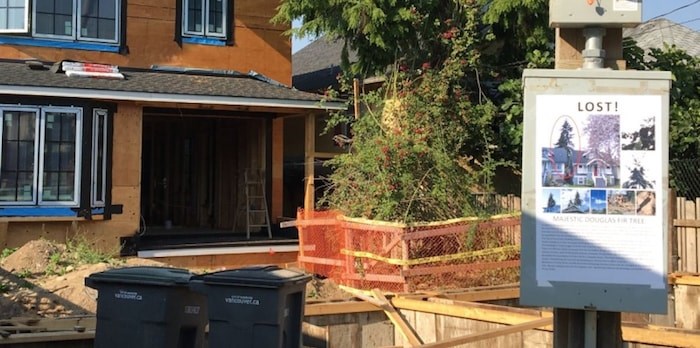“A beautiful Douglas fir tree native to the West Coast stood tall for more than 65 years before being violently cut down in a few hours on Friday, July 20, 2018.”
So begins that has been circulating around my East �鶹��ýӳ��neighbourhood, which seeks penalties against a developer and builder. It has so far garnered 128 signatures and 72 mostly furious comments.
 The removal of a 65-plus-year-old Douglas fir upset a number of East �鶹��ýӳ��residents who’ve started a petition to seek penalties against a developer and builder. Photo Grant Lawrence
The removal of a 65-plus-year-old Douglas fir upset a number of East �鶹��ýӳ��residents who’ve started a petition to seek penalties against a developer and builder. Photo Grant Lawrence
Even if you don’t know the details of this story, you’ll probably recognize the scenario. An old house was purchased and rented out for a few months. Then the tell-tale plastic orange fence framed by two-by-fours was erected around the city trees along the sidewalk.
“Dad,” declared my five-year-old son, obviously a born-and-bred Vancouverite. “The orange fence! That means that house is going to be ripped down, right?”
Right.
You know the deal after that: the house is demolished, usually in a day, along with pretty much every living thing on every square centimetre of the lot, something I call the scorched earth syndrome.
I get why certain houses are tear downs, and why it’s cheaper to build from the ground up than to renovate, but I’ve never understood why every bush, tree and blade of grass must be ripped out, chopped down and overturned before a new house can be built.
“It’s because contractors are basically trying to build homes as fast as humanly possible,” explained a busy �鶹��ýӳ��contractor who insisted he not be named. He currently has four major jobs on the go, none of which are the development in question. “Most builders don’t really care about trees and foliage and will find any reason to get rid of them. It’s just way easier to work with a bare lot than have to work around bushes and trees, both above ground and below.”
I assumed as much. Apparently, the city will allow you to remove any bush or tree on your property with a trunk that measures less than 20 centimetres in diameter at a height of 1.4 metres from the ground. That’s roughly a 64-cm circumference. If you want to get rid of anything measuring 20 cm across or larger, you need a tree removal permit, and that’s a procedure that will involve either a certified arborist or an accredited plumber.
Among various other reasons, the tree you want to remove has to be proven to be interfering with your sewage line or water main, or is “dead, dying, or hazardous.”
There must be a hell of a lot of builders finding hazardous trees in this town, because the scorched earth method of development seems omnipresent and appears contrary to the city’s Urban Forest Strategy announced in 2014, the goal of which is to plant 150,000 trees by 2020.
“It’s not morally right, but trees create obstacles,” said the contractor I spoke to. “If a builder doesn’t like what one arborist has to say, they get another one.”
The neighbourhood petition states that “the landmark tree was not only an eagle habitat but also offered protection and sustenance to other wildlife. Residents close by benefitted from its cooling shade.” It was one of three trees planted by the former homeowners to commemorate the births of their children.
So… what happened?
According to a confusing account of the incident in the �鶹��ýӳ��Sun, the city ordered the tree in question to be protected. To do that, the foundation wall of the property’s laneway house couldn’t be built deeper than 45 centimetres.
An onsite arborist apparently expressed concern about the tree’s roots once they were exposed. A second arborist was brought in who said the roots looked fine. At some point, the city was supposedly alerted that the excavation might have compromised the tree.
A stop-work order was placed on the entire construction, and the tree was deemed hazardous. After growing to a lofty height of about 70 feet since the early 1950s, it was gone in a day. Construction resumed, with the condition that the owner will eventually plant a replacement tree. With the Urban Forest Strategy in mind, shouldn’t two trees be planted for every one removed?
“Residents of Trinity Street and the Burrardview/Hastings-Sunrise community are outraged at the death of this tree and its removal,” states the petition.
It’s a tough situation. The owner of the property said the plan was to keep the tree. To his credit, he saved some other bushes and shrubs with orange fencing. He intends to live in the home with his young family, which includes two toddlers. It’s a hell of an unfortunate way to enter into a close-knit neighbourhood.
When those initial questions about the roots arose, the owner supposedly tried calling city hall multiple times.
“It can be really frustrating dealing with city hall when it comes to trees, but if you go in person to the Development and Building Services Centre at 10th and Cambie, you’ll never wait more than 20 minutes,” said the anonymous contractor I spoke told to. “And by the way, they’re watching you. They have aerial Google views of the city for every year going back to 2007 and can zoom right in on your property. If you mess with a tree, they’re going to know about it. They’re basically hippies with power.”
The city is still investigating the matter. Right or wrong, the total or near-total excavation of lots clearly needs attention if in fact the city is serious about its healthy urban forest plan.


